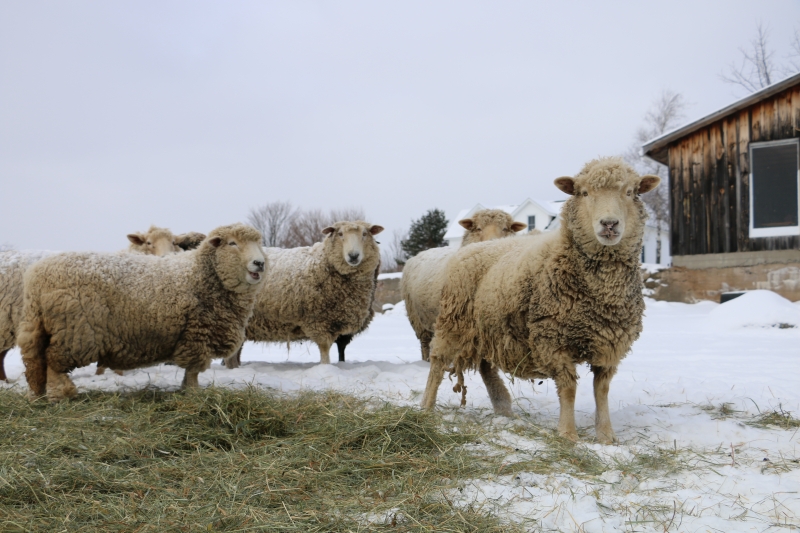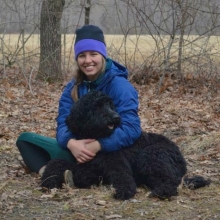
The Wonders of Wool
Driving through St. Lawrence County, no matter what time of year, it's not uncommon to see herds of livestock along the roadsides. The strong speckled bodies of cows stand together in groups, their hooves barely denting the frozen ground beneath them. Sheep gather around mounds of hay, some of them practically camouflaged under the piles of snow that accumulate on their backs.
Most North Country residents have the blessing of a heat source this winter. Whether it is in the form of an old wool sweater, a cup of tea, or a crackling fire, we usually rely on some supplemental external heat to warm our bodies. The animals that live alongside us don't, yet they seem more resilient to harsh temperatures and biting winds than we are.

Sheep seem particularly unaffected by extreme winters - while cows and goats may be more inclined to seek shelter from the elements, sheep stay standing stoically in their pastures. They sure have one thing going for them - their wool sweaters. Wool has some of the best insulating properties of any natural fiber, which is why we rely on it so much in our own clothing. It's thanks to the lanolin, the waxy substance that coats their fleeces, that sheep are able to endure all sorts of weather. Lanolin comes from special glands that are unique to wool bearing animals, but sheep secrete more of the wax than others. It acts as an oil, which repels water from the fibers and creates a barrier between the sheep's skin and the air. Moisture can't get in, and heat can't get out. That's why snow piles up on a sheep's back instead of melting; their body heat is contained so closely and tightly to their skin that not enough heat is projected outwards to melt the snow.

Lanolin is what makes wool yarn so special to work with even after it has left the backs of sheep. Becky Graham, of the Celtic Knot in Canton, prefers to knit with wool over any other fiber. "It's just smooth but grabby, and then the finished things are just cozy and that sort of thing," she explained as her tiny double pointed needles clicked together with each stitch. A sleeve of a sweater emerged as she worked - a project that she admitted was long overdue.
Becky learned how to crochet when she was eight years old and started knitting about ten years ago. She credits it with constantly teaching her something new, and values its unifying qualities.
"There's something really wonderful about knitting alone, there's something very meditative and therapeutic about that. And then there's something so incredibly naturally social about knitting that's just fantastic. Even if you're learning, even if you're frusterated, even if you want to throw it across the room, which at times they did, it was really about camraderie and getting through it together."
Linda Kenny of Canton also started her knitting career at the age of eight - a magic age in the fiber world, apparently. Becky and Linda, as well as many others, belong to a knitting group that meets at the Celtic Knot every Wednesday afternoon from three to five. Wool is also Linda's favorite fiber to work with, she explained as she worked on the second of a pair of blue socks. It's a form of stress relief for her, every stitch that she makes conversely acts like an unraveling of internal tension.
"I like knitting in meetings. I knit all through graduate school and probably most of my undergraduate. It helps you focus."
 Linda wore a vibrant sweater that her daughter had knit for her years ago to keep her warm on a particularly nasty North Country day, but she said it hadn't always been that way. Back in 1967, oil was 19 cents a gallon and heating homes was inexpensive. "You could just crank it right up and wear sleeveless things all winter long." Of course, the sheep still lived outside, so they still relied on their own bulky sweaters to keep them warm.
Linda wore a vibrant sweater that her daughter had knit for her years ago to keep her warm on a particularly nasty North Country day, but she said it hadn't always been that way. Back in 1967, oil was 19 cents a gallon and heating homes was inexpensive. "You could just crank it right up and wear sleeveless things all winter long." Of course, the sheep still lived outside, so they still relied on their own bulky sweaters to keep them warm.
Wool isn't the only thing that sheep have going for them; they have another secret to keeping warm that, try as we might, we just won't be able to evoke. Sheep have ruminant stomachs, which means that the grass and hay they eat is fermented internally. Fermentation of these fibrous substances creates heat that warms the sheep from the inside out, similar to how we feel when we drink hot tea or coffee. This also means that the more sheep eat in the winter, the warmer they will be.
Sheep are clearly well suited to live outside in North Country winters, probably more so than the rest of us, which is why wool has become so popular. The sheep that spend most of their time outside are typically healthier animals than those that are confined inside; they get more exercise than they would in a barn, and they are able to breath drier and fresher air. Ventilation is crucial - moist barn air can turn toxic when mixed with a buildup of ammonia fumes from urine.
But just because sheep can withstand the frigid cold, doesn't mean they necessarily want to all of the time. As with any livestock, care and kindness go a long way. Adequate shelter and windbreaks are just as important as access to fresh air, and don't be afraid to throw out a little extra hay this season.
For now, we can all try to take a page from the survival book of the sheep to battle this sporadic North Country weather: get fresh air, eat well, and wear wool sweaters. Maybe we should listen to Linda too - she thinks that if more people knit, there would be no more war.

All photographs © 2016 Lizz Muller


I'm pretty sure Linda is right - if more people knit, there would be no war!